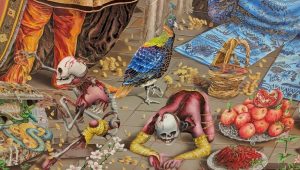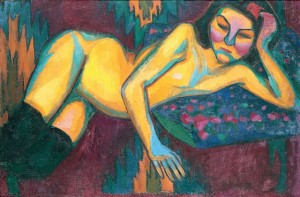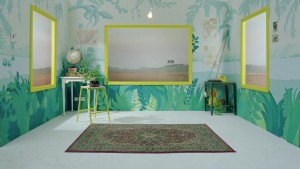
1 When did you start to make art?
My teacher in the second year of primary school said I should be an artist. I was about 7 years old at the time and had just won the Surrey County Council Litter campaign poster competition. The idea stuck.
2 How did you evolve into a professional artist?
I studied Art at Central Saint Martins and graduated in 2004 with a degree in fine art. I’ve been practising as a fine artist ever since.
3 What drove you to make art as a professional vocation?
There has never been any doubt that art was to be my chosen career, I believe any other vocation would inhibit my creativity.
4 Explain your inspiration?
I’m obsessed with the paper minutiae we all leave behind throughout our lives. I collect my own day-to-day, score house clearances, source from charity shops, flea markets, the national achieves, the national register office and I’ve even been known to pick up tickets, papers and receipts from the street.
5 In what way does your inspiration transform into ideas?
I select fragments of these documents and transform them into gigantic hand painted monuments.
6 From Ideas to production of art – how? And why?
Each item is fragmented and meticulously reproduced on a massive scale in very thin layers of acrylic paints, giving it a print-like quality. This fragmental approach allows the artist to manipulate the viewer’s gaze, censoring or emphasising its elements to convey particular themes. The viewer is left devoid of the wider context, prompting them to re-contextualize the fragment on their own accord. The change in scale, also, illuminates the fragment’s content; this acts as a metamorphosis of both form and meaning, magnifying connotations that may have gone unnoticed in its original scale and transient form. Subsequently, the mundanity of the subject is elevated, giving the paintings a transcendental quality. Receipts, certificates, tickets and ephemera are aggrandized; they become memory–fragments, denoting a personal narrative, tracing a history, or even conveying a societal shift. They are fragments of personal and private experience. But through decontextualization they are given a universality that allows space for the viewer’s own private and emotive response.
7 Could your ideas be portrayed in any other medium? If so which?
I don’t think my ideas are only limited to paint only. I’ve often thought film would work and I’ve already made some installations that have a direct link with my paintings.
8 Which artists would you most like to blatantly rip off?
None, art is about being the originator of work.
9 Why is your art made?
The artwork is the transformation of the found object to large-scale painting, if I simply showed the original documents a lot of my ideas would go unnoticed. This process is the key to the success of my paintings.
10 What does being an artists mean to you?
It gives me flexibility in which to be creative.
11 Are you happy with your reasons for making art? i.e Are there any trade offs that make life hard?
Security is almost impossible when you are working full time as an artist. But this can also be looked upon as a positive, an antidote to mundanity.
12 When does your art become successful?
Primarily the piece is successful if it conveys what the artist wants it to communicate. I think success in the art world is a different thing entirely; it combines recognition, commercial success, endorsement and there are different measurements and varying degrees of this success.
13 What is art?
‘There really is no such thing as Art. There are only artist’ E.H Gombrich. This is quite simply the best answer to this question and I don’t think I can better it. Society is fabricated to ease our existence and art is one of the best things to have emerged from this.
14 How do you start the process of making work?
Researching a particular idea, formulating a concept and then finding a fragment to express that conception.
15 Who prices your work? And how is the price decided upon?
I look to the market, the materials and time taken to make the piece and take advice from peers, collectors and gallerists to price my work.
16 What is your next; move,project,show etc?
The next body of paintings I’m working on are made in response to modern manifestation of the seven deadly sins; I hope to show these towards the end of next year. I’m also showing a piece in the charity exhibition ‘400 Women’ amongst the artists involved are Stella Vine, Tracey Emin, and I will be fronting, along with 8 other artists, Winsor & Newton’s new ‘Artists’ Acrylic’ launch campaign.
17 What are the pros and cons of the art market?
Art continues to be a great investment, which in turn financially supports artists. However there are some negative associations surrounding this. Sometimes the art world seems very highbrow and inaccessible, this limits collectors and then well-established collectors tend to control trends in the market and movements in art. Buyers tend to invest in work that has been endorsed by elite collectors, purely for the investment not because they like the work.
18 Which pieces would you like to be remembered for?
I would hope for a retrospective of my paintings.
19 Any routine in making your artwork? If so what?
I don’t have a strict routine; sometimes I will be in the studio till the early hours alternatively I may feel like stepping back from a painting for some time. During this process creativity isn’t forced and ultimately one will end-up with a better result.
20 What has been the biggest break in your career?
I can’t single one out; I’ve had several breaks that have been turning points in my career.
21 Who has been the biggest influence on you?
I believe society and the media influence my work this has a direct reflection on my concepts, which deal with societal shifts and humanity’s obsession with the material.
22 How many artworks have you given away and to whom?
I’ve given away several art works to raise money for charity auctions like ‘Africa Roots’ raising money for the Inkanyiso Day Care Centre. I’ll soon be donating a piece to ‘400 Women’, a larger scale exhibition in response to the rape and murder of over 400 women in the US border town Cuidad Juarez. 400 artists will each paint one of the murdered women or their name.
More Info:HERE







